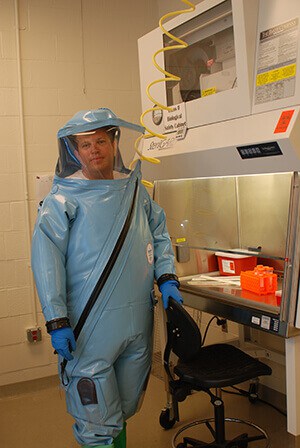What if Zoloft and Vascor—safe prescription drugs that you can pick up at your CVS for depression and heart trouble, respectively—could treat Ebola?
A government study led by a researcher at BU’s National Emerging Infectious Diseases Laboratories (NEIDL) suggests that this may be the case. If confirmed effective in humans—a finding that immunologist Gene Olinger says will take several years—doctors might sprint to a treatment well ahead of the standard 15-year, $1 billion-and-up process of developing and marketing a new drug.
When the researchers treated 10 mice infected with Ebola with Vascor (bepridil), customarily used to control blood pressure in heart patients, all the mice survived the often-deadly virus. When they treated 10 mice with the antidepressant Zoloft (sertraline), 7 survived. The next step, Olinger says, will be to test the drugs in guinea pigs and monkeys.
Olinger is associate director for maximum containment training at NEIDL and a School of Medicine adjunct associate professor of infectious diseases. His study’s drug analysis was done at his lab in Maryland, where he works as a contractor with the National Institutes of Health. NEIDL, on the Medical Campus in Boston’s South End, is awaiting approval for Biosafety Level 4 research, which would include on-site, live-virus Ebola studies.
“This is exactly the type of work that the NEIDL was designed to support,” says NEIDL director Ronald Corley, a MED professor. Olinger’s research, like NEIDL’s, he says, aims at “taking our basic understanding of pathogens and translating that information into potential therapies.”
Olinger’s work with viral hemorrhagic fevers (VHF) such as Ebola began a dozen years ago, when he was a civilian employee with the Army. Ebola has killed more than 11,000 Africans in an outbreak that began a year and a half ago alone.
“We started to develop a drug screen using a live virus” that might find effective therapies, Olinger says. Given the time and expense—and failure rate—of developing new drugs, “I was tasked to find a way to do something quickly.” It made sense to screen existing Food and Drug Administration–approved drugs, not just for the time saved, but because “the repurposing approach has been used in infectious diseases before,” he says. He cites two prominent examples: Viagra was originally a heart treatment drug before its effectiveness against erectile dysfunction was discovered, and thalidomide—used for nausea in pregnant women until it was found to cause birth defects—today is “a very good cancer drug.”
Olinger and his team screened 2,600 drugs, representing 90 percent of the FDA-approved pharmaceutical library, he says. Of those screened, 80, ranging from antihistamines to treatments for breast cancer, heart disease, and depression, appeared to have some effectiveness against Ebola. The drugs were put in dishes along with cells infected with the disease, to see if the drugs might block the virus. Those that looked most effective were tested in mice.
Olinger says the effective drugs appear to work by damming up cellular pathways through which Ebola enters. “We do know there are synergistic combinations that are possible,” he says, meaning that an ultimate therapy might involve a cocktail of several drugs, similar to the way HIV is treated.
The findings of Olinger and his team, published last week in the journal Science Translational Medicine, surprised even him. “I was shocked at the breadth of the type of drugs that had an impact,” he says, such as drugs blocking estrogen receptors in the cells. “Why would a virus need an estrogen receptor?” he says. “I could see years of research just on a basic level just off that one finding.”
Olinger is a codeveloper of ZMapp, an experimental drug that has shown promise against Ebola during the recent African outbreak. He had hoped to go to Africa to help with the outbreak, he says, but was thwarted when the private firm he works for couldn’t get insurance to cover any evacuation costs. Instead, he filled in for colleagues who did go during meetings in Geneva of the World Health Organization.

